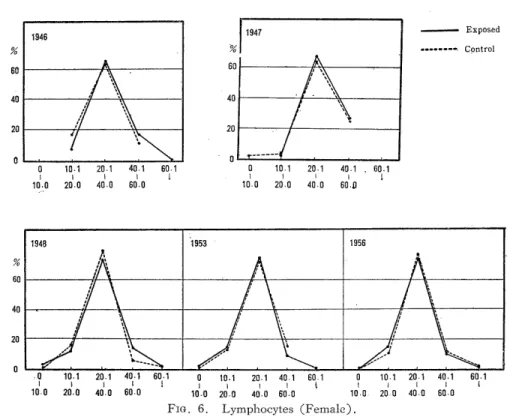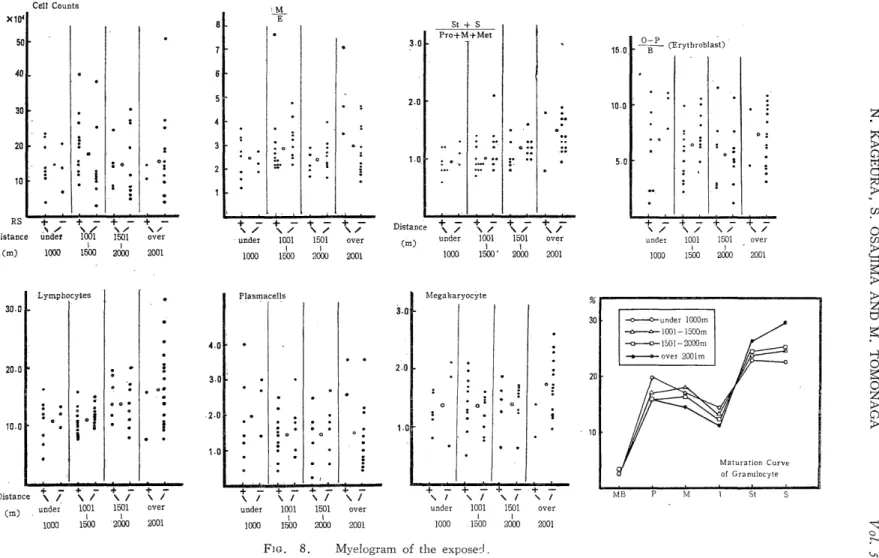Acta med. nagasaki. 5 : 1 - 12 (1960)
Blood Picture of Nagasaki Atomic Bomb Survivors *1
Naomi KAGEURA, Shiro OSAJIMA AND Masanobu TOMONAGA *2 Second Department of Internal Medicine, Nagasaki University
School of Medicine, Nagasaki, Japan
Received for publication February 8, 1960
The results of hematological studies in Nagasaki on atomic bomb (A-bomb) survivors which were carried out at Second Department of Internal Medicine from 1946 to 1956 have been brought for summary. 1) Anemic and leukopenic tendency revealed in the exposed in 1946 and 1947 has recovered as time went on, no difference being noticed in 1948 in cases of leukopenia and in 1956 in cases of anemia comparing with the control. 2) The incidence of eosin- ophilia in the exposed showed a characteristic variation from 1947 to 1953, which may be related to the A-bomb radiation. However, in 1956, no diffe- rence was noticed between the exposed and control. 3) In general, the tend- ency of restoring to normal values was extremely strong in the exposed in each item of investigation. Accordingly, so far as concerned with peripheral blood, no significant difference was observed between the exposed and con- trol in 1956. 4) However, the clinical investigation of bone marrow in the exposed performed in 1956, still suggested a possibility of maturation arre- st of granulocytic and megakaryocytic series in the short distance exposed.
5) Three cases of chronic myelocytic leukemia were found in these mass survey, two of them being in an early stage of the disease.
The immediate and acute effects of A-bomb radiation on human beings, especi- ally the injuries to hematopoietic organs, were clarified to a large extent by many studies. So it has become very important to determine whether such injuries have recovered or continued, that is, if there could be any delayed, longterm, or chronic
effects many years after A-bomb explosion.
Several blood surveys of the Nagasaki A-bomb survivors exposed within 2000m from the hypocenter have been carried out by various staff members of Second
Department of Internal Medicine for over ten years. Findings from these investiga- tions have been brought up-to-date for summary.
MATERIALS AND METHODS
Hematological examination (hemoglobin, WBC count and differential) of the survivors exposed within 2000m from the hypocenter of the atomic bombing in Nagasaki were performed, in 1946, 1947, 1948, 1953 and 1956. The number of the survivors examined were 94, 61, 77, 2927 and 3234 respectively and that of the controls who were simultaneously examined were 69, 33, 110, 361 and 1607.
They were classified as illustrated in Table 1 into A, B and C, according to presen- ce or abscence of acute radiation symptoms (epilatiian, hemorrhagic tendency, stom- atitis) and were further divided in 18 smaller groups by sex and age. Although
*L Presented at the 19th General Meeting of the Japan Hematological Society. Tokyo, Japan. April 3, 1957.
紹 影 浦 尚 視 ・籏 島 四 郎 ・朝 長 正 允
TABLE 1.
The Number of Survivors Examined 1946
Sex F T
Age Y
1. Y~ Group
_ ~' ~
A 89 5 0 94
C 60 9 0 69
T 149 I 14 0 163
Total 163
1947
Sex F T
Age
Group Y.1 Y2 Y
A 55 6 0 61
C 28 5 0 33
T 83 11 0 94
Total 94
1948
Sex F T
Age Y
7 Y2 Ys Group
A 13 15 2 30
B 18 22 7 47
C 88 22 0 110
T 119 59 9 187
Total 187
Remarks :
A Exposed under 2000m with major radiation symtoms.
B Exposed under 2000m without major radiation symptoms
C Control.
T : Total, Y1 8-23 years.
Yz 24-58 years, Y3 58 years and over.
1953
Sex M F T
~~Age
Y1 Ya ` Ys Y1 ` Y2 ` Yae
Group \. _
A 125 248 44 132 484 54 1,087
B 221 307 111 346 767 127 1,885
C 78 91 22 80 83 7 361
T 430 646 177 558 1,334 188
Total 1,263 2,080 3,333
1956
Sex M F T
Age Y
Y Y2 Ys Y 1 Y2 Ys Group
A 102 505 86 I 132 576 76 1,477
B 307 472 97 310 485 86 1,757
C 185 416 146 205 522 133 1,607
T 594 1,393 329 647 1,583 295
Total ~ 2,316 --- 2,525 4,841
-

